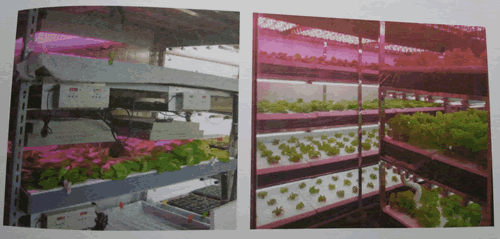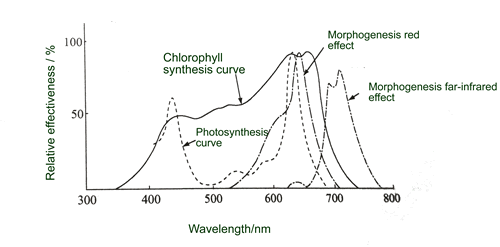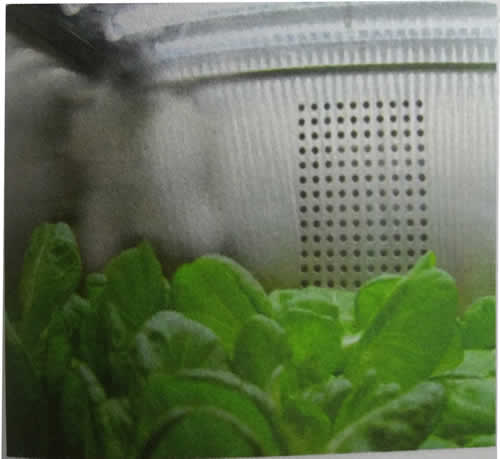Plant Growing in Green House

Artificial light system
Plant photosynthesis and light demand
Effect of light intensity on plant photosynthesis
On the one hand the strength of the light affects photosynthesis intensity, while changing the form of crops, such as flowers, internode length, thickness and other stem and leaf size and thickness. In a certain co2 concentration and a certain range of light intensity, photosynthetic intensity with increasing light intensity increases. When light intensity than light saturation point, not only does not increase the net photosynthetic rate, but also the formation of inhibitory chlorophyll decomposition caused by physiological disorders of crops. Differences between different types of plants greater light saturation point, light saturation point generally increases with the environment co2 concentration increased.


Effect of light quality on crop photosynthesis
wavelength from 400-700nm is mainly absorbed by plant photosynthesis energy range, called photosynthetically active radiation. wavelength from 700-760nm is far infrared light, the light of the completion of plant morphology play a role. In the process of photosynthesis in plants, it absorbs most of the red, orange light (660-680nm), followed by blue-violet light and ultraviolet (300-500nm), little green 9500-600nm) absorption. UV wavelength optimum short section, can inhibit the growth of crops, crucify spores; the longer wavelength part, can promote seed germination, fruit ripening, increase protein, vitamins and sugar content; infrared also germination and growth of plants have a stimulating effect, and thermal effects.
Effect of different spectral components on the effect of different plants, under strong light blue light can promote the synthesis of chlorophyll, and the red light will hinder its synthesis. While photosynthesis plant red light is an important energy source, but if not with the blue light will result in plant morphology abnormalities. Experiments show that the appropriate red (600-700nm) / blue light (400-500nm) ratio (R / B ratio) in order to ensure healthy plants cultivated form. Appropriate red light (600-700nm) / far-infrared light (700-800nm) ratio (R / FR ratio) can regulate plant morphology is formed, a large R / FR ratio can be shortened internode spacing and play dwarfing plants effect, contrary small R / FR ratio can promote the growth of plants.
| Wavelength/nm | Plant |
| >1000 | After being absorbed by plants, it converted into heat energy, affecting the organism temperature and transpiration, can improve the accumulation of dry matter, but do not participate in photosynthesis |
| 1000-720 | Elongation of plant work. 700-800nm is called far-red radiation ,which plays an important role to photoperiod and seed formation , and control the flowers and color of fruit |
| 720-610 | Mainly red, orange color - is strongly absorbed by chlorophyll, which photosynthesis is strongest, some cases showed a strong photoperiod effect |
| 610-510 | Mainly green - chlorophyll absorb is less, photosynthetic efficiency is low |
| 510-410 |
Mainly blue-violet light - chlorophyll absorption is max, a strong role in shaping and photosynthesis |
| 410-320 | The role of shaping and coloring |
| <320 | For most plant pests that could cause stomata to close photosynthesis, and lead bacteria infection |
Effect of photoperiod on plants
Representation of light intensity
1) illumination: Lx
lm
1lx = 1lm / m2
2) PAR (photosynthetically active radiation) W / M2
3) PPFD / PPF (photosynthetic photon flux density): umol / (m2.s)
In plant growing light field, the common is PPFD / PPF.
LED plant lighting design:
→ different light quality and quantity of light needs: Adjust the number of LED wavelengths
Blue → low, stocky growth
Red → tall and leggy
→ fluorescent light sources can be used directly to replace the white LED (red region energy?)
→ LED can pulse (pulse) drive
→ leafy uses red + blue light can be
Plant Growing in Home

Home micro plant growing device is need to suit home decroation, so it required the structure more compact and easy for maintance, and it require good design apperance .
some power heating light such as (high-voltage sodium lamp, fluorescent lamp will not be suit for such application. LED have advantage at heat reduce, color combination, energey save, long life time, wich can decrease the layer distance, keep the space more compact, it is the best choice for plant growing device in home
Now micro plant growing device in home usually choice combined white color. Because in home, man's vision prefer the light close to daylight. blue color + red color combination in green house is irritating. mainly we recommend R(660nm)+G(550nm)+B(450nm)
Related Products
2.8*3.5 SMD LED
BL-LS3528C0S1URC-660
BL-LS2835C0S1PGC-550
BL-LS3528C0S1UBC-450


